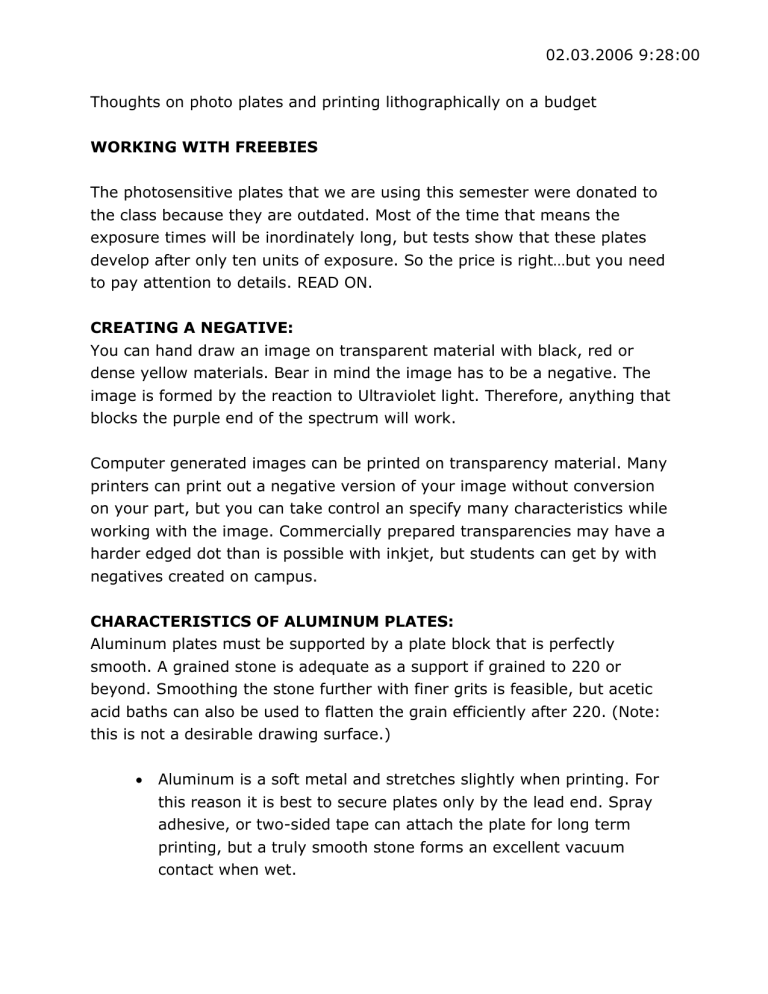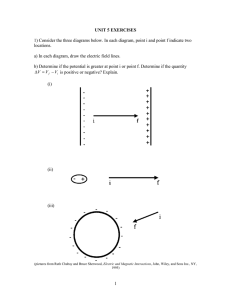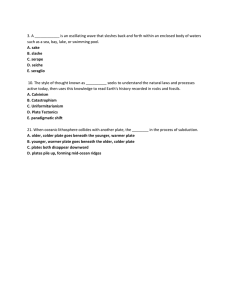Photolithographic Process 2006 donated plates details

02.03.2006 9:28:00
Thoughts on photo plates and printing lithographically on a budget
WORKING WITH FREEBIES
The photosensitive plates that we are using this semester were donated to the class because they are outdated. Most of the time that means the exposure times will be inordinately long, but tests show that these plates develop after only ten units of exposure. So the price is right…but you need to pay attention to details. READ ON.
CREATING A NEGATIVE:
You can hand draw an image on transparent material with black, red or dense yellow materials. Bear in mind the image has to be a negative. The image is formed by the reaction to Ultraviolet light. Therefore, anything that blocks the purple end of the spectrum will work.
Computer generated images can be printed on transparency material. Many printers can print out a negative version of your image without conversion on your part, but you can take control an specify many characteristics while working with the image. Commercially prepared transparencies may have a harder edged dot than is possible with inkjet, but students can get by with negatives created on campus.
CHARACTERISTICS OF ALUMINUM PLATES:
Aluminum plates must be supported by a plate block that is perfectly smooth. A grained stone is adequate as a support if grained to 220 or beyond. Smoothing the stone further with finer grits is feasible, but acetic acid baths can also be used to flatten the grain efficiently after 220. (Note: this is not a desirable drawing surface.)
Aluminum is a soft metal and stretches slightly when printing. For this reason it is best to secure plates only by the lead end. Spray adhesive, or two-sided tape can attach the plate for long term printing, but a truly smooth stone forms an excellent vacuum contact when wet.
The wider the margin, the easier it is to print…”Run-off” the space on either side of the image allows the printer to lift the roller without stopping. In addition, narrow margins allow liquid to ooze from under the plate while printing.
The surface of photo plates is almost slick. The mat finish does not hold a great deal of water so things can go wrong in a hurry. To
make up for this you must pay attention.
There are several differences between stone and plate lithography.
CHEMICAL DIFFERENCES:
IF WORKING ON BARE ALUMINUM the chemistry balance needs to be kept within a narrow range. There are no bubbles to indicate effective use of acid. The preferred acids for aluminum are tannic, and phosphoric. Rather than count drops of phosphoric, there is a bottle of “tannic” etch prepared in advance.
Tannic acid is long organic molecule similar to gum Arabic but
(perhaps) tougher and longer than gum. Therefore, once attached it the plate, it retains water well.
Apply tannic etch to photo plates only after they have been developed and inked. It can be used full strength (It seems.) but is usually used in fifty percent solution with gum.
Cleaning plates mid-printing: Occasionally, in stone lithography we resort to a wet-wash out of ink by adding solvents directly into water and wiping the resulting mess aside before inking again. AGE or asphaltum-gum-etch is an equivalent process for plates. AGE contains grease, acid, gum, and detergents. It must be shaken prior to use as all components are needed…and they separate.
Other products: o FPC or white gold…Finisher, Plate Cleaner is comparable to
AGE but more gentle. o “Mag” wheel cleaner…intended for alloy wheels, this product contains an ingredient for removing oxidation from aluminum.
It is used only in dilute solutions and is needed when adding fresh drawing, or converting photo plates to waterless lithography.
Another Press!
We have a 1906 Charles Wagner offset proofing press that can be used to print plates or stones. The pressure settings are very sensitive.
You may use this with guidance only.
Palm press: Designed by Nic Semenoff, this press is a set of bearings mounted precisely in a palm-sized holder. By use of hand pressure, this tool can be used to print images. I find it most useful for light, relatively open, imagery. I would place solid areas on a separate plate if I desired to print both solid color and lines on the same paper with this tool.
Another roller: In addition to the leather rollers devoted to black ink, we have smooth rollers made of composite materials…basically rubber. These rollers have no knap and attention must be paid to slab thickness and roller speed to print successfully.
Three-part roller: This is assembled from donated press parts. It is intended for waterless lithography, but its small diameter inking rollers have advantages in applying color very evenly.
BASIC PRINTING FROM ALUMINUM:
Wet the plate with water, or water with gum (fountain solution.)
Using a dry sponge, pull the water film down to a minimum thickness.
Roll quickly over the plate and back.
Repeat sponging and inking cycle.
Adjust slab thickness to print efficiently…usually three visits to the slab per print.
Inspect your results…proceed.
Printing problems and approach for OUR photo plates:
1.
Have a back up plan: If I’m printing in color, I have a black slab available.
I have AGE, and solvents readily available.
2.
Bear in mind how smooth the plates are…and how little water they hold.
Rather than making multiple passes back and forth over the plate, you may roll over and back once and then sponge again.
3.
Pay attention to details: The edge of your plate may hide liquid that will squirt out under printing pressure. Clean it up before printing. Water in ink and ink in water scum have a different appearance. Treat each
4.
according to its needs.
If your sponging water is turning the color of your print, you are creating ink in water…a hazy mix of half ink and water that will settle over your plate. To correct this stiffen your ink with magnesium carbonate, and work in a long varnish such as number
8 that will resist mixing with water. In addition, you may be using too much water. Limit the amount on your plate to as little as
possible.
If large knots of ink or threads of ink are sticking to the edges of your image, you are creating water in ink scum. Most likely, you have an area of your plate that is drying quicker than others and you have dry-rolled an area. Following that, you passed over the wayward ink deposit with a wet sponge and released all or most of that ink in a new contaminated condition. Inspect your plate and working area. While it is wet, look across your plate toward a light source. Areas that are drying quickly will become visible as the plate dries. STOP printing and clean your plate. Massage the plate with AGE and follow that with tannic acid/gum etch (50/50) BUFF to a thin film without talc. Let the plate rest and resume printing after ten to twenty minutes.
02.03.2006 9:28:00
02.03.2006 9:28:00






